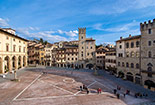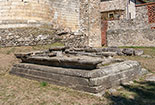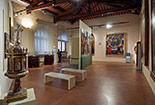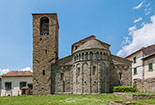A LARGE ROMAN AMPHITHEATRE
in Arezzo, Tuscan art city that you can know in every detail with this website
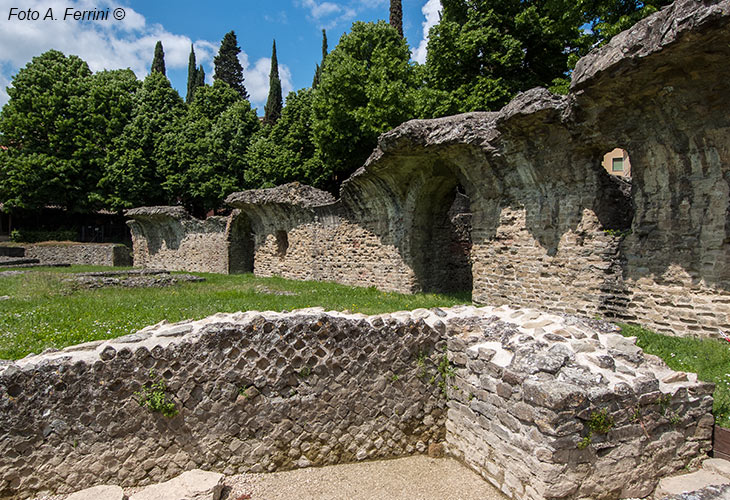
Texts and photos by Alessandro Ferrini ©
30 images in sequence showing many aspects of the Roman Amphitheatre in Arezzo. Click to enlarge
An amphitheatre as testimony of the Roman Empire in Arezzo
 In the history of Arezzo there is an important Roman period. The most evident evidence of this link between the Tuscan city and Rome are the ruins of a large Roman amphitheater of the first half of the second century AD located between Via Crispi and Via Margaritone. On a part of the perimeter of this ellipsoidal structure was built in the fourteenth century the St. Bernard Monastery, now home to the Archaeological Museum of Arezzo.
In the history of Arezzo there is an important Roman period. The most evident evidence of this link between the Tuscan city and Rome are the ruins of a large Roman amphitheater of the first half of the second century AD located between Via Crispi and Via Margaritone. On a part of the perimeter of this ellipsoidal structure was built in the fourteenth century the St. Bernard Monastery, now home to the Archaeological Museum of Arezzo.
The Roman amphitheatre was built under the emperor Hadrian (117-138 AD) and testifies to the importance that Arezzo had for the "Eternal City". In fact, if the Tuscan city was initially a place to be taken away from the Etruscans, then a stopover point for the movement of the Romans to the north, later the place became a garrison of Rome. This meant that many Roman citizens moved to Arezzo. Hence the need to build for these people structures that would satisfy their habits, their customs. This large open-air theatre was one of them.
As mentioned above, the amphitheatre has an elliptical shape and its dimensions are truly remarkable. Measured externally in its major axis is about one hundred and twenty meters, the smaller one is almost seventy meters. With the decadence of the Roman Empire, the amphitheatre of Arezzo also experienced a similar fate. Time has played its part, but it was mainly the plundering of its materials that decreed its progressive ruin, fortunately not total. Over the centuries it has been a convenient stone and marble quarry for the construction of other buildings. The St. Bernard Monastery is the most evident. This was founded in the round ones of the amphitheatre's grandstands.
 What remains of this important Roman structure, clearly visible thanks to the restorations that were held in various stages during the twentieth century, now allows you to understand much of this amphitheater. The material used was mostly sandstone, but good use was also made of marble and bricks. The Arezzo amphitheatre had a stalls and a tribune, the latter consisting of two orders. To allow access and movement of people (it is estimated that it could contain 8/9000) there was a ring between the large arena and the stalls and two covered corridors under the bleachers. Of the latter, only the inner one remains. Very interesting are the vaulted entrances to the amphitheatre. There were four. Two at the major axis, two at the minor axis. Fascinating openings of almost two thousand years ago that today allow to have particular views of the arena and the Monastery of San Bernardo. From the loggia of this building, which has been the Archaeological Museum of Arezzo since 1937, one has an overall view of this archaeological site, which is normally not open to visitors. Another beautiful view of the Roman amphitheater of Arezzo is from the path that runs next to a part of its perimeter.
What remains of this important Roman structure, clearly visible thanks to the restorations that were held in various stages during the twentieth century, now allows you to understand much of this amphitheater. The material used was mostly sandstone, but good use was also made of marble and bricks. The Arezzo amphitheatre had a stalls and a tribune, the latter consisting of two orders. To allow access and movement of people (it is estimated that it could contain 8/9000) there was a ring between the large arena and the stalls and two covered corridors under the bleachers. Of the latter, only the inner one remains. Very interesting are the vaulted entrances to the amphitheatre. There were four. Two at the major axis, two at the minor axis. Fascinating openings of almost two thousand years ago that today allow to have particular views of the arena and the Monastery of San Bernardo. From the loggia of this building, which has been the Archaeological Museum of Arezzo since 1937, one has an overall view of this archaeological site, which is normally not open to visitors. Another beautiful view of the Roman amphitheater of Arezzo is from the path that runs next to a part of its perimeter.



